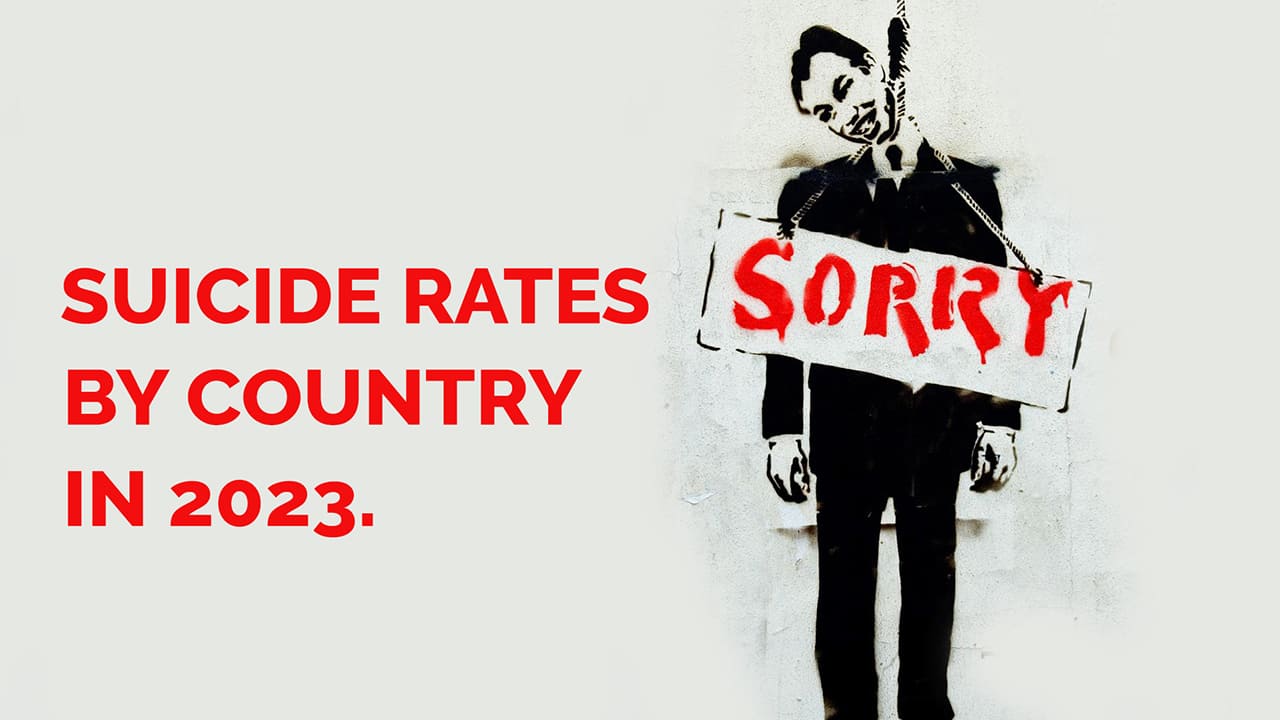
Suicide Rates by Country in 2023.
Suicide is a pressing global issue that impacts individuals, families, and entire communities. It is a complex topic influenced by various factors such as socioeconomic conditions, cultural beliefs, and mental health challenges. Understanding suicide rates by country can provide valuable insights into the underlying causes and help shape effective prevention strategies.
Examining suicide rates across different countries reveals patterns and trends that can guide suicide prevention efforts. By identifying countries with high suicide rates and the factors contributing to them, interventions can be tailored to reduce the number of suicides. Likewise, studying countries with low suicide rates can offer valuable lessons and strategies that can be implemented elsewhere.
10 Countries with the Highest Suicide Rates
The table below shows number of suicides per 100k population:
| Rank | Country | Female Rate | Male Rate | Total Suicide Rate |
| 10 | South Africa | 9.8 | 37.6 | 23.5 |
| 9 | Russia | 9.1 | 43.6 | 25.1 |
| 8 | Suriname | 11.8 | 38.8 | 25.4 |
| 7 | Lithuania | 9.6 | 45.4 | 26.1 |
| 6 | Micronesia | 12.7 | 43.2 | 28.2 |
| 5 | Kiribati | 8.7 | 48.6 | 28.3 |
| 4 | South Korea | 16.9 | 40.2 | 28.6 |
| 3 | Eswatini | 4.7 | 55.1 | 29.4 |
| 2 | Guyana | 17.4 | 63 | 40.3 |
| 1 | Lesotho | 30.1 | 116 | 72.4 |
Suicide rates are influenced by a range of factors, including cultural beliefs, economic conditions, and the availability of mental health resources. Analyzing these factors across countries allows for a more comprehensive understanding of suicide and its potential solutions.
Countries with the highest suicide rates typically face a combination of societal, cultural, and economic challenges that contribute to extreme mental distress. For example, Lesotho, a small landlocked country in southern Africa, struggles with a severe economic downturn, leading to high unemployment rates and widespread poverty, which are significant factors in its high suicide rate.
Guyana, a country in South America, reports the second-highest suicide rate globally, with young people being particularly affected. This is attributed to high levels of poverty, inequality, and limited access to mental health services.
10 Countries with the Lowest Suicide Rates
| Rank | Country | Total Suicide Rate | Male Rate | Female Rate |
| 10 | Jamaica | 2.4 | 3.7 | 1.1 |
| 9 | Philippines | 2.2 | 3.1 | 1.2 |
| 8 | Venezuela | 2.1 | 3.5 | 0.7 |
| 7 | Honduras | 2.1 | 3.3 | 0.8 |
| 6 | Jordan | 1.6 | 2.5 | 0.7 |
| 5 | Sao Tome And Principe | 1.5 | 2.2 | 0.8 |
| 4 | Saint Vincent And The Grenadines | 1.0 | 1.3 | 0.6 |
| 3 | Grenada | 0.7 | 0.6 | 0.7 |
| 2 | Barbados | 0.6 | 0.9 | 0.3 |
| 1 | Antigua And Barbuda | 0.4 | 0 | 0.8 |
Eswatini, a small kingdom in southern Africa, has the third-highest suicide rate globally. The country grapples with the world’s highest HIV/AIDS prevalence, as well as poverty, inequality, limited access to mental health services, and the stigma surrounding mental illness.
In South Korea, societal pressure to succeed, intense competition, and social isolation contribute to high suicide rates, especially among young people. While progress has been made in raising awareness about mental health and suicide prevention, cultural and societal attitudes toward mental illness remain challenges.
Despite the difficulties faced by these countries, numerous organizations and individuals are dedicated to raising awareness, providing support, and promoting mental health. Governments, NGOs, and community groups are working together to address the complex issues surrounding suicide and provide resources for those in need.
On the other hand, countries with the lowest suicide rates offer insights into successful strategies for promoting mental health and well-being. Nations like Antigua and Barbuda, Barbados, and Grenada in the Caribbean have close-knit communities and family-oriented cultures that contribute to their low suicide rates. Strong social support systems and cultural values emphasizing family and community cohesion act as protective factors against suicidal thoughts and behaviors.
Jordan, located in the Middle East, stands out for its low suicide rate despite the region’s generally high prevalence of mental health disorders. This achievement suggests that effective mental health interventions can overcome cultural and societal barriers, offering hope for other countries in the region and beyond.
The success of these countries in preventing suicide can serve as inspiration for the rest of the world to prioritize mental health and well-being. By investing in mental health resources, promoting supportive communities, and addressing the contributing factors, countries can make significant progress in reducing the global burden of suicide.
In conclusion, suicide is a multifaceted issue influenced by mental health, socioeconomic factors, access to lethal means, and cultural norms. Suicide rates vary greatly by country, necessitating tailored interventions and improved access to mental health resources. Governments must prioritize mental health, combat stigma, increase resource availability, and regulate access to lethal means.
Individuals experiencing suicidal ideation or behavior should seek professional help from trusted healthcare providers, mental health professionals, or support groups. It is crucial to remember that help is available, and no one needs to face these challenges alone.
By working together, both countries and individuals can make strides in reducing the number of lives lost to suicide and promoting mental well-being worldwide.